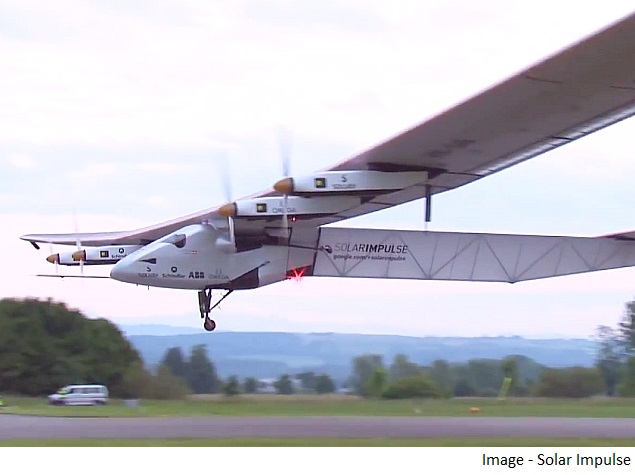- Home
- Science
- Science News
- Bad Weather Casts Doubt on Solar Impulse 2 Pacific Flight
Bad Weather Casts Doubt on Solar Impulse 2 Pacific Flight

Solar Impulse 2 was in a holding pattern over the Sea of Japan on Monday as organisers warned that bad weather in the days ahead could block the aircraft's ambitious bid to cross the Pacific Ocean.
The seventh leg of the round-the-world journey was set to take pilot Andre Borschberg, 62, on a six-day, six-night flight from the Chinese city of Nanjing across the Pacific Ocean to Hawaii, an 8,500-kilometre (5,270-mile) flight.
Borschberg completed Solar Impulse 2's first overnight leg, with the aircraft relying solely on batteries charged by the sun's energy, but poor weather ahead threw the rest of the marathon leg into doubt.
"Yesterday we had the possibility to cross the weather front just before Hawaii on day five," the Solar Impulse team said in a statement.
"However, with the forecasts we now have, we don't see this possibility anymore, which means that for the moment the road to Hawaii is blocked."
Borschberg will stay in a holding pattern over the Sea of Japan, a map on the team's website showed.
"Whilst we wait for the forecasts, we have decided to hold the position of the aircraft. We have asked Andre to stay where he is," the statement said.
Organisers still held out the possibility of continuing the leg, however.
"During this time we will analyse where he will have to go to find a possibility to cross that front," the statement said.
The journey began in Abu Dhabi in March and is scheduled for 12 legs, with a total flight time of around 25 days.
Promote green energy
The flight from Nanjing to Hawaii is the longest section of the maiden solar-powered global circumnavigation, an attempt to promote green energy.
The journey began in Abu Dhabi in March and is scheduled for 12 legs, with a total flight time of around 25 days.
Speaking on Saturday hours before the departure from Nanjing, Borschberg told reporters that the plane could land in Japan in case of technical problems.
Planners had identified airports in Japan should the plane need to make a stop, but the open ocean offers no such possibility, he said.
"As soon as we leave this part of the world, then afterwards we are in the open sea. There is no way to come back," Borschberg said.
But failure could mean a parachute descent into the ocean, hundreds of kilometres (miles) from rescue.
No ship is trailing the plane as it travels far too fast for a maritime vessel to keep up with, even though its maximum speed of 140 kilometres an hour is much slower than conventional jet aircraft.
Solar Impulse 2 is powered by more than 17,000 solar cells built into wings that, at 72 metres, are longer than those of a Boeing 747 and approaching those of an Airbus A380 superjumbo.
The plane is the successor of Solar Impulse, which notched up a 26-hour flight in 2010, proving its ability to store enough power in lithium batteries during the day to keep flying at night.
Ridiculed by the aviation industry when it was first unveiled, the venture has since been hailed around the world, including by UN chief Ban Ki-moon.
For the latest tech news and reviews, follow Gadgets 360 on X, Facebook, WhatsApp, Threads and Google News. For the latest videos on gadgets and tech, subscribe to our YouTube channel. If you want to know everything about top influencers, follow our in-house Who'sThat360 on Instagram and YouTube.
Related Stories
- Galaxy S24 Series
- MWC 2024
- Apple Vision Pro
- Oneplus 12
- iPhone 14
- Apple iPhone 15
- OnePlus Nord CE 3 Lite 5G
- iPhone 13
- Xiaomi 14 Pro
- Oppo Find N3
- Tecno Spark Go (2023)
- Realme V30
- Best Phones Under 25000
- Samsung Galaxy S24 Series
- Cryptocurrency
- iQoo 12
- Samsung Galaxy S24 Ultra
- Giottus
- Samsung Galaxy Z Flip 5
- Apple 'Scary Fast'
- Housefull 5
- GoPro Hero 12 Black Review
- Invincible Season 2
- JioGlass
- HD Ready TV
- Laptop Under 50000
- Smartwatch Under 10000
- Latest Mobile Phones
- Compare Phones
- Motorola Edge 50 Ultra
- Leica Leitz Phone 3
- Moto G64 5G
- Moto G04s
- iQOO Z9 Turbo
- Vivo T3x 5G
- Realme P1 5G
- Realme P1 Pro 5G
- Asus ZenBook Duo 2024 (UX8406)
- Dell Inspiron 14 Plus
- Realme Pad 2 Wi-Fi
- Redmi Pad Pro
- Cult Shock X
- Fire-Boltt Oracle
- LG 65-inch 4K Ultra HD Smart LED TV 65UR7500PSC
- Xiaomi 32 Inch LED HD Ready Smart TV (L32M6-RA-L32M7-RA)
- Sony PlayStation 5 Slim Digital Edition
- Sony PlayStation 5 Slim
- Hitachi 1 Ton 5 Star Inverter Split AC (RAS.V512PCAISH)
- Panasonic 1.5 Ton 3 Star Inverter Split AC (CS/CU-EU18AKY3)

















